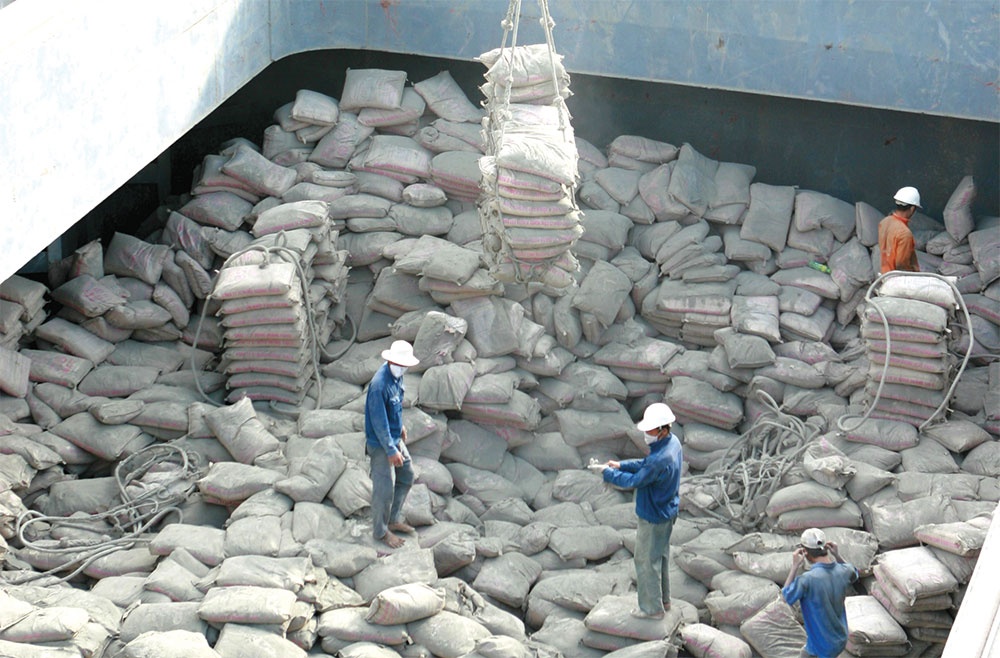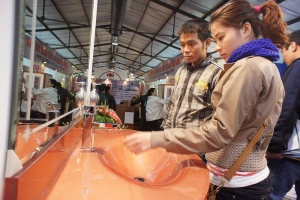Hopes for advances in building materials
 |
| 2024 is going to be a tough one for the cement industry, photo Le Toan |
The Ministry of Construction last week released the 2023 production and business report, in which the building materials sector, particularly the cement industry, rendered a quite disappointed picture.
Cement production was estimated at 89.4 million tonnes, down 5.45 per cent on-year, and consumption fell to around 89 tonnes, down 6 per cent on-year.
Around 57 million tonnes were sold in the domestic market, showing a 10 per cent fall, while export of cement and clinker came to 32.6 million tonnes, slightly up by 2 per cent on-year. The export value, however, shed by more than 10 per cent to just $1.23 billion in 2023.
The domestic market has been the main consumer of the cement sector, each year snapping up 62-65 million tonnes of products over the past five years. This year, the figure sank below the 60 million-tonne benchmark.
Consumption of the cement sector had shed 15 million tonnes on-year in 2022 compared to 2021, making the 2023 picture even more critical.
The director of one cement business with a system of cement plants in the provinces of Ninh Binh, Ha Nam, and Nghe An revealed that the company’s business has been so bleak, they have had to halt several production lines to mitigate losses.
Meanwhile, state-owned Vietnam Cement Industry Corporation (Vicem), reported that by the end of the third quarter, many of its 10 member units have counted losses.
In the first nine months of this year, Vicem Ha Tien, the largest unit in the system, reported $222 million in the revenue, down more than 20 per cent on-year. Its profit contracted $1.5 million, whereas the company counted $8.5 million in the same period last year.
Amid slow consumption, Vicem Hoang Mai, another key member, had to halt its kiln operations for a month and reduce clinker production in Q3 to avoid rising inventory. In the first three quarters of 2023, the company incurred $1.09 million in losses.
Many cement plants have had to halted operation to downsize inventory in the past year. As of now, nearly 10 cement production lines reportedly sit idle across the country.
Meanwhile, the production output in 2023 for facing tiles and slabs was estimated at 386.5 million square metres, down 15 per cent on-year, and consumption fetched around 291.5 million sq.m, taking a 25 per cent dip on-year.
Similarly, ceramic plumbing fixture production output approximated 12.5 million items, down 25 per cent on-year, and consumption was around 11 million items. Construction glass output reached 211 million sq.m, slightly down by 2 per cent on-year, and consumption approximated 168 million sq.m.
The Ministry of Construction (MoC) assumes that the poor performance came in the context that many construction projects saw delays in implementation, and input cost saw a spike.
According to an MoC report, by the end of Q3 in 2023, supply of real estate items was stressed in all segments. The commercial housing segment saw the completion of 42 projects with almost 16,000 apartments, equal to nearly half compared to one year ago. Resort property and office-residential complexes saw the completion of 17 projects, equal to 57 per cent compared to a year ago.
Firms say that the way out for the building materials industry in 2024 is public investment disbursement acceleration as a driving force for economic growth, with many key transport infrastructure projects being implemented.
Vicem CEO Le Nam Khanh said, “As the cement industry is still in the stage of oversupply, and consumption in both domestic and export markets see no positive factors, 2024 is forecast to be another tough year for the cement industry. For the porcelain segment, due to huge production capacity and curtailed consumption since 2021, the segment runs at just 60 per cent of its designed capacity.”
Dinh Xuan Huy, chairman of the Vietnam Construction Ceramics Association, noted, “A frozen real estate market, firms lacking capital, lending rates fetching high, and high taxes compared to actual conditions have resulted in a stagnant building materials market. Unless these impediments are solved, a significant number of porcelain firms will go bust.”
In this context, eight business associations in the construction sector have been crying for help to the government.
In December, the MoC sought comments from the ministries of finance as well as industry and trade, along with the State Bank of Vietnam (SBV), about solutions to help firms in the building materials industry for submission to the government.
The MoC also asked the Ministry of Transport to command project developers to increase the use of reinforced viaducts at highway projects in the design stage, particularly in areas prone to floods and with weak soil, as well as those lacking materials for building roads, such as in the Mekong Delta region.
The MoC, the SBV, and localities shall continue expediting $5.06 billion of a preferential credit package for the development of social housing, workers’ residential blocks, and renovating old-style residential complexes.
The ministry also proposes reducing the clinker export tax rate to zero until the end of 2025; cutting lending rates by up to 2 per cent for businesses producing building materials in the same timeframe; and extending the deadline on charging no interest on overdue debts and restructured loans to reduce difficulties for businesses.
According to the MoC report, total production and business value of firms under its management reached an estimated $2.4 billion, equal to 85 per cent compared to one year ago, and 88 per cent of the full-year projection.
| Phan Ho Chau Nam, Deputy general director Nhan Luat Investment and Steel Trading Corporation |
| We have encountered myriad hardships as 2023 was quite a challenging year to the domestic economy, and to the construction sector in particular. The multiple hardships are associated with a dip in customer demand, increasingly stiff market competition, weakening credit health of businesses in the sector, and increasingly stringent lending requirements from banks. Notably, steel exports eyed an inspiring growth surpassing 64 per cent, in which hot-rolled steel and cold-rolled steel products championed 157 and 127 per cent hikes in volume, followed by construction steel which saw a spike of more than 50 per cent. The figures mirror the fact that the steel sector has witnessed upbeat signals in the latter months of the year, yet the demand was mainly fueled by export, meanwhile local demand has proven weak. The upward trend in the last months of the year is mainly due to storage demand when construction steel prices often tend to increase from the end of the year to the first months of the following year. In general, the building material industry is still facing multiple hardships as the current domestic growth drivers are focused mainly on the government’s public investment factor, while the real estate market is still facing myriad difficulties that cannot be removed immediately. Nhan Luat is not outside of the scope of influence when current supply of local factories is much greater than actual demand. This has amplified the level of competition between domestic steel producers and traders, and imported goods sources. To weather stormy times, we have simultaneously expedited diverse internal and external measures. On the one hand, we promote market development, continuously searching and connecting information from all players in the system. On the other hand, the sales organising stage was also reviewed and connections were promoted with appropriate and cost-effective service providers. For 2024, it is now too early to say about real estate market rebound albeit the macroeconomic picture has seen positive changes. This year, the GDP growth was 5.05 per cent, and inflation would be softened to 3.5 per cent. Especially from the beginning of 2025, when laws related to the real estate market take effect, it will promote recovery. |
| Luong Duc Long, general secretary Vietnam Cement Association |
| Since its formation more than a century ago, this has been the most difficult period for the cement sector. It is under pressure on output due to the poor absorption capacity of the local economy. Along with that, rising input cost due to rising energy prices has put the industry under considerable pressure. Meanwhile, market demands have taken a dip. The output market faces a standstill, leading to mounting unsold stock. This has exacerbated firms’ difficulties with many units facing constant losses. The supply-demand imbalance between regions in the country, along with increased transportation and logistics costs, has affected cement supply in several regions, such as the South Central Coast and Central Highlands, cushioning production and business efficiency. Cement supply continues to exceed demand by about 40 million tonnes, irrespective of a number of new investment projects going into operation. There are expectations that the government shall continue efforts to accelerate public investment disbursement pace in 2024, making an important contribution to stimulating demand and pushing up production and business activities. This will definitely have a positive impact on the performance of the building material industry, including in cement. Along with that, a raft of measures to remove roadblocks in real estate market development must be executed, from there bolstering demands for cement consumption in the domestic market. Simultaneously, diverse policies to help businesses remove difficulties in production and trading shall be applied to support their development in 2024. |
 | Tough times for building materials sector The construction materials industry has seen revenue drop by $1 billion over the last two years and is valued at approximately $2 billion annually at present, far below its pre-pandemic figures. This observation came from Dinh Quang Huy, chairman of Vietnam Building Ceramics Association at a seminar held on June 10 in Hanoi seeking measures to help building materials firms out of their current difficulties. |
What the stars mean:
★ Poor ★ ★ Promising ★★★ Good ★★★★ Very good ★★★★★ Exceptional
Related Contents
Latest News
More News
- Businesses ramp up production as year-end orders surge (December 30, 2025 | 10:05)
- Vietjet chairwoman awarded Labour Hero title (December 29, 2025 | 13:06)
- How to unlock ESG value through green innovation (December 29, 2025 | 10:03)
- AI reshapes media and advertising industry (December 29, 2025 | 08:33)
- FPT and GELEX sign deal to develop blockchain tech for global markets (December 29, 2025 | 08:29)
- Vietnam’s GDP forecast to grow by 9 per cent in 2026 (December 29, 2025 | 08:29)
- Women entrepreneurs are key to Vietnam’s economic growth (December 29, 2025 | 08:00)
- Vietnam's top 500 value-creating enterprises announced (December 27, 2025 | 08:00)
- The PAN Group shaping a better future with ESG strategy (December 26, 2025 | 09:00)
- Masan Consumer officially lists on HSX, marking the next phase of value creation (December 25, 2025 | 13:20)

 Tag:
Tag:




















 Mobile Version
Mobile Version